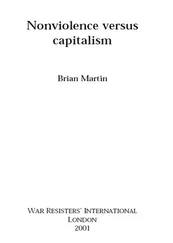On university-military links, see Annals of the American Academy of Political and Social Sciences, Vol. 502, March 1989; David Dickson, The New Politics of Science (New York: Pantheon, 1984), chapter 3; Jonathan Feldman, Universities in the Business of Repression: The Academic-Military-Industrial Complex and Central America (Boston: South End Press, 1989); Daniel S. Greenberg, The Politics of Pure Science (New York: New American Library, 1971); Stuart W. Leslie, The Cold War and American Science: The Military-Industrial-Academic Complex at MIT and Stanford (New York: Columbia University Press, 1993); Christopher Simpson (ed.), Universities and Empire: Money and Politics in the Social Sciences During the Cold War (New York: New Press, 1998); Clark Thomborson, “Role of military funding in academic computer science,” in David Bellin and Gary Chapman (eds.), Computers in Battle — Will They Work? (Boston: Harcourt Brace Jovanovich, 1987), pp. 283-296.
Bruno Vitale, “Scientists as military hustlers,” in Issues in Radical Science (London: Free Association Books, 1985), pp. 73-87.
David Cortright, Peace Works: The Citizen’s Role in Ending the Cold War (Boulder: Westview Press, 1993), pp. 179-186; Steve Nadis, “After the boycott: how scientists are stopping SDI,” Science for the People , No. 20, January-February 1988, pp. 21-26.
Alan D. Beyerchen, Scientists under Hitler: Politics and the Physics Community in the Third Reich (New Haven, CT: Yale University Press, 1977). I thank Mary Cawte for mentioning this reference.
On scientists as a reserve labour force see Chandra Mukerji, A Fragile Power: Scientists and the State (Princeton, NJ: Princeton University Press, 1989).
Eric Schatzberg, “Ideology and technical choice: the decline of the wooden airplane in the United States, 1920-1945,” Technology and Culture , Vol. 35, No. 1, January 1994, p. 34-69.
James William Gibson, The Perfect War: Technowar in Vietnam (Boston: Atlantic Monthly Press, 1986).
Vincent Mosco, “The military information society and ’star wars’,” in The Pay-Per Society: Computers and Communication in the Information Age (Toronto: Garamond, 1989), pp. 131-172, also published in revised form as “Strategic offence: star wars as military hegemony,” in Les Levidow and Kevin Robins (eds.), Cyborg Worlds: The Military Information Society (London: Free Association Books, 1989), pp. 87-112.
Paul N. Edwards, The Closed World: Computers and the Politics of Discourse in Cold War America (Cambridge, MA: MIT Press, 1996).
Hilary Wainwright and Dave Elliott, The Lucas Plan: A New Trade Unionism in the Making? (London: Allison and Busby, 1982).
David Dickson, The New Politics of Science (New York: Pantheon, 1984), pp. 141-145.
Lance J. Hoffman (ed.), Building in Big Brother: The Cryptographic Policy Debate (New York: Springer-Verlag, 1995).
Leslie J. Freeman, Nuclear Witnesses (New York: Norton, 1981); Brian Martin, “Nuclear suppression,” Science and Public Policy , Vol. 13, No. 6, December 1986, pp. 312-320.
Daniel M. Berman and John T. O’Connor, Who Owns the Sun? People, Politics, and the Struggle for a Solar Economy (White River Junction, Vermont: Chelsea Green, 1996); Ray Reece, The Sun Betrayed: A Report on the Corporate Seizure of U.S. Solar Energy Development (Boston: South End Press, 1979).
Brian Martin, “Suppression of dissent in science,” Research in Social Problems and Public Policy, Vol. 7, 1999, pp. 105-135.
Elting E. Morison, Men, Machines, and Modern Times (Cambridge, MA: MIT Press, 1966), chapter 2.
John Ellis, The Social History of the Machine Gun (London: Croom Helm, 1975).
James Fallows, “The American Army and the M-16 rifle,” in Donald MacKenzie and Judy Wajcman (eds.), The Social Shaping of Technology (Milton Keynes: Open University Press, 1985), pp. 239-251.
Mary Kaldor, The Baroque Arsenal (London: Andre Deutsch, 1982).
Dave Grossman, On Killing: The Psychological Cost of Learning to Kill in War and Society (Boston: Little, Brown, 1995).
There is a large amount of writing about various forces that have weakened the power of the state, including transnational corporations, international organisations and social movements. Undoubtedly the state is no longer hegemonic, if it ever was. When it comes to examining the military, the state remains the dominant influence, but there is an increasing role being played by mercenaries, militias and international “peacekeeping” forces. Mary Kaldor, New and Old Wars: Organized Violence in a Global Era (Cambridge: Polity Press, 1999) provides an insightful analysis of the recent transformation of war from state-based invasion-and-defence mode to a postmodern form with state, paramilitary, criminal and international actors involved in a mixture of war, organised crime and mass human rights violations.
On the state and the military, see Ekkehart Krippendorff, Staat und Krieg: Die Historische Logik Politischer Unvernunft (Frankfurt: Suhrkamp, 1985), as reviewed by Johan Galtung, “The state, the military and war,” Journal of Peace Research , Vol. 26, No. 1, 1989, pp. 101-105 (I thank Mary Cawte for this reference); Bruce D. Porter, War and the Rise of the State: The Military Foundations of Modern Politics (New York: Free Press, 1994); Charles Tilly, Coercion, Capital, and European States, AD 990-1992 (Cambridge MA: Blackwell, 1992). For the case of the US, see Gregory Hooks, Forging the Military-Industrial Complex: World War II’s Battle of the Potomac (Urbana: University of Illinois Press, 1991).
Andreas Speck notes that an alternative interpretation is that centralised energy systems are more a result of capitalist interests, with big companies using their control to keep competitors small and dependent.
A self-reliant system is much more useful in an actual war, since it cannot be destroyed as easily. The point here is that centralised systems, through their very vulnerability, provide a stronger justification for military defence.
Maurice Pearton, The Knowledgeable State: Diplomacy, War and Technology since 1830 (London: Burnett Books, 1982).
For a nice treatment of different relationships between the state and war industry in the United States, see Gregory Hooks and Gregory McLauchlan, “The institutional foundations of warmaking: three eras of U.S. warmaking, 1939-1989,” Theory and Society , Vol. 21, 1992, pp. 757-788.
See for example Carl Gustav Jacobsen, “Arms Build-ups under Socialism: The USSR and China,” in N. P. Gleditsch and O. Njølstad, (eds.), Arms Races: Technological and Political Dynamics (London: Sage, 1990), pp. 285-294.
Читать дальше












